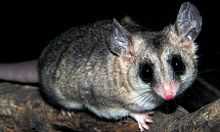Thylamys
| Thylamys[1] | |
|---|---|
 | |
| Elegant Fat-tailed Mouse Opossum | |
| Scientific classification | |
| Kingdom: | Animalia |
| Phylum: | Chordata |
| Class: | Mammalia |
| Infraclass: | Marsupialia |
| Order: | Didelphimorphia |
| Family: | Didelphidae |
| Genus: | Thylamys Gray, 1843 |
| Type species | |
| Didelphis elegans Waterhouse, 1839 | |
| Species | |
|
See text | |
Thylamys is a genus of opossum in the family Didelphidae. The premaxillae are rounded rather than pointed. The females lack a pouch. The females' nipples are arranged in two symmetrical rows on the abdomen[2] All species but T. macrurus store fat in their tails.,[3] although this is not necessarily true for all species in the genus.[4]
The genus contains the following species:
- Cinderella Fat-tailed Mouse Opossum (Thylamys cinderella)
- (Thylamys citellus) [5]
- Elegant Fat-tailed Mouse Opossum (Thylamys elegans)
- (Thylamys fenestrae) [6]
- Karimi's Fat-tailed Mouse Opossum (Thylamys karimii)
- Paraguayan Fat-tailed Mouse Opossum (Thylamys macrurus)
- White-bellied Fat-tailed Mouse Opossum (Thylamys pallidior)
- (Thylamys pulchellus) [7]
- Common Fat-tailed Mouse Opossum (Thylamys pusillus)
- Argentine Fat-tailed Mouse Opossum (Thylamys sponsorius)
- Tate's Fat-tailed Mouse Opossum (Thylamys tatei)
- Dwarf Fat-tailed Mouse Opossum (Thylamys velutinus)
- Buff-bellied Fat-tailed Mouse Opossum (Thylamys venustus)
Fossils belonging to the genus date back to the Miocene, with the oldest specimens being found in Argentina and Colombia.[8] Genetic studies indicate that the genus may have originated around 14 million years ago.[9]
References
- ↑ Gardner, A. L. (2005). "Order Didelphimorphia". In Wilson, D. E.; Reeder, D. M. Mammal Species of the World (3rd ed.). Johns Hopkins University Press. pp. 17–18. ISBN 978-0-8018-8221-0. OCLC 62265494.
- ↑ Eisenberg, John Frederick; Redford, Kent Hubbard (1999). Mammals of the Neotropics: The Central Neotropics: Ecuador, Peru, Bolivia, Brazil. University of Chicago Press. p. 624. ISBN 978-0-226-19542-1.
- ↑ Gardner, Alfred L. (2008). Mammals of South America: Marsupials, xenarthrans, shrews, and bats. University of Chicago Press. p. 669. ISBN 0-226-28240-6.
- ↑ Voss, R.S. & Jansa, S.A. (2003). "Nonmolecular data and new IRBP sequences: separate and combined analyses of didelphine relationships with denser taxon sampling". Bulletin of the American Museum of Natural History 276: 1–82. doi:10.1206/0003-0090(2003)276<0001:PSODMI>2.0.CO;2.
- ↑ http://www.iucnredlist.org/apps/redlist/details/199835/0
- ↑ http://www.iucnredlist.org/apps/redlist/details/199836/0
- ↑ http://www.iucnredlist.org/apps/redlist/details/199834/0
- ↑ Braun, J.K. et al. (2005). "Phylogenetic and biogeographic relationships of mouse opossums Thylamys (Didelphimorphia, Didelphidae) in southern South America". Journal of Mammalogy 86 (1): 147–159. doi:10.1644/1545-1542(2005)086<0147:PABROM>2.0.CO;2.
- ↑ Steiner, C. et al. (2005). "New DNA data from transthyretin nuclear intron suggest an Oligocene to Miocene diversification of living South American opossums (Marsupialia: Didelphidae)". Molecular Phylogenetics and Evolution 35: 363–379. doi:10.1016/j.ympev.2004.12.013.